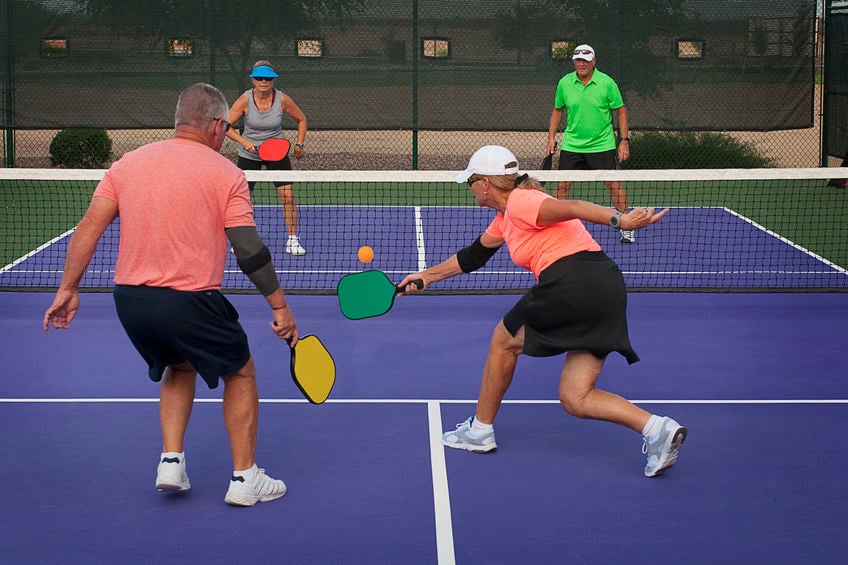Pesky Pickleball Pains
In recent years, pickleball has become an increasingly popular sport for the aging adult. By nature, the activity is social and provides cardiovascular and muscular strengthening benefits. There have even been studies that have shown that playing pickleball can lower blood pressure and decrease the chances of depression. However, a common ailment for the pickleball player is chronic shoulder pain. What can people do to keep discomfort at bay? Is rotator cuff surgery necessary?

What’s that pain?
The most common type of shoulder pain associated with pickleball is shoulder impingement. Impingement can be caused by pinching of tendons or bursae brought on by a chronic condition like arthritis. Or, the impingement can simply be caused by overuse and repetitive motion, such as during pickleball, especially when the strength and stability of the shoulder are lacking.
How do I fix the pain?
This type of shoulder pain is especially common in people over the age of 60. Symptoms include pain that worsens when lying on the side, pain with movement, or while performing certain activities, such as buckling a seatbelt or reaching behind the back. Unfortunately, the pain will not go away without corrective action.
The first course of treatment
For many people, shoulder impingement can improve with physical therapy. A physical therapist can work with patients one-on-one to strengthen and stabilize the area around the joint. This specialist also helps patients understand how to move in a way that prevents future injury. A physical therapist may also use pain management strategies such as ice and heat to help decrease discomfort.
Do I need surgery?
Shoulder impingement is characterized by overuse or injury of the rotator cuff tendons. If a patient receives treatment for the impingement and pain doesn’t improve within 6 months, a doctor may recommend rotator cuff surgery. Surgical repair may also be necessary if there is a tendon tear.
Surgery options
The most common procedure for this type of shoulder pain is a subacromial decompression (SAD). During the operation, the surgeon removes bone tissue to increase the space in the ball-and-socket shoulder joint. This helps to decrease the pain and squeezing in the rotator cuff. The surgery may also involve slightly shaving down the bone or removing a bone spur. This procedure improves symptoms in up to 90% of patients who have not had success with other treatments.
Is it time to talk to the pros?
While shoulder pain from pickleball is common, players should not assume the discomfort will go away without treatment. If the pain gets worse with movement and doesn’t go away after a few weeks, speak with a shoulder specialist. A healthcare provider can provide treatment options to help decrease shoulder pain and help patients find relief.
Can Lower Back Pain Return After Spinal Surgery? 3 Lifestyle Changes To Get The Most Out Of Fusion
Minnesota Valley Valley Center2024-04-02T14:49:38-05:00April 15th, 2024|
Spinal surgery is an excellent solution for lower back pain, but symptoms can return. With lifestyle changes, patients can get the most out of fusion.
A New Lease On Life: Exploring How Robotic Total Joint Replacement Can Get You Active Again
Minnesota Valley Valley Center2024-03-24T17:38:47-05:00March 29th, 2024|
Robotic total joint replacement uses a robotic arm to replace the joint. This innovative approach allows a quick return to activities.
Restoring Dexterity: How Outpatient Carpal Tunnel Surgery Can Change Your Life
Minnesota Valley Valley Center2024-03-24T17:38:37-05:00March 15th, 2024|
After months of wrist and hand pain, carpal tunnel surgery may be needed. With outpatient options, restored dexterity with less pain and discomfort is possible.
More Articles from MVSC
April 15, 2024
Spinal surgery is an excellent solution for lower back pain, but symptoms can return. With lifestyle changes, patients can get the most out of fusion.
February 29, 2024
Rotator cuff tears can severely limit shoulder mobility. Surgery can relieve pain and improve mobility, allowing patients better reach.
January 15, 2024
Spinal conditions in the lower back may require a procedure called laminectomy. With MIS, patients have higher success rates.
December 21, 2023
Clavicle fractures are often treated non-surgically. The location and degree of damage can indicate whether collarbone surgery is needed.










